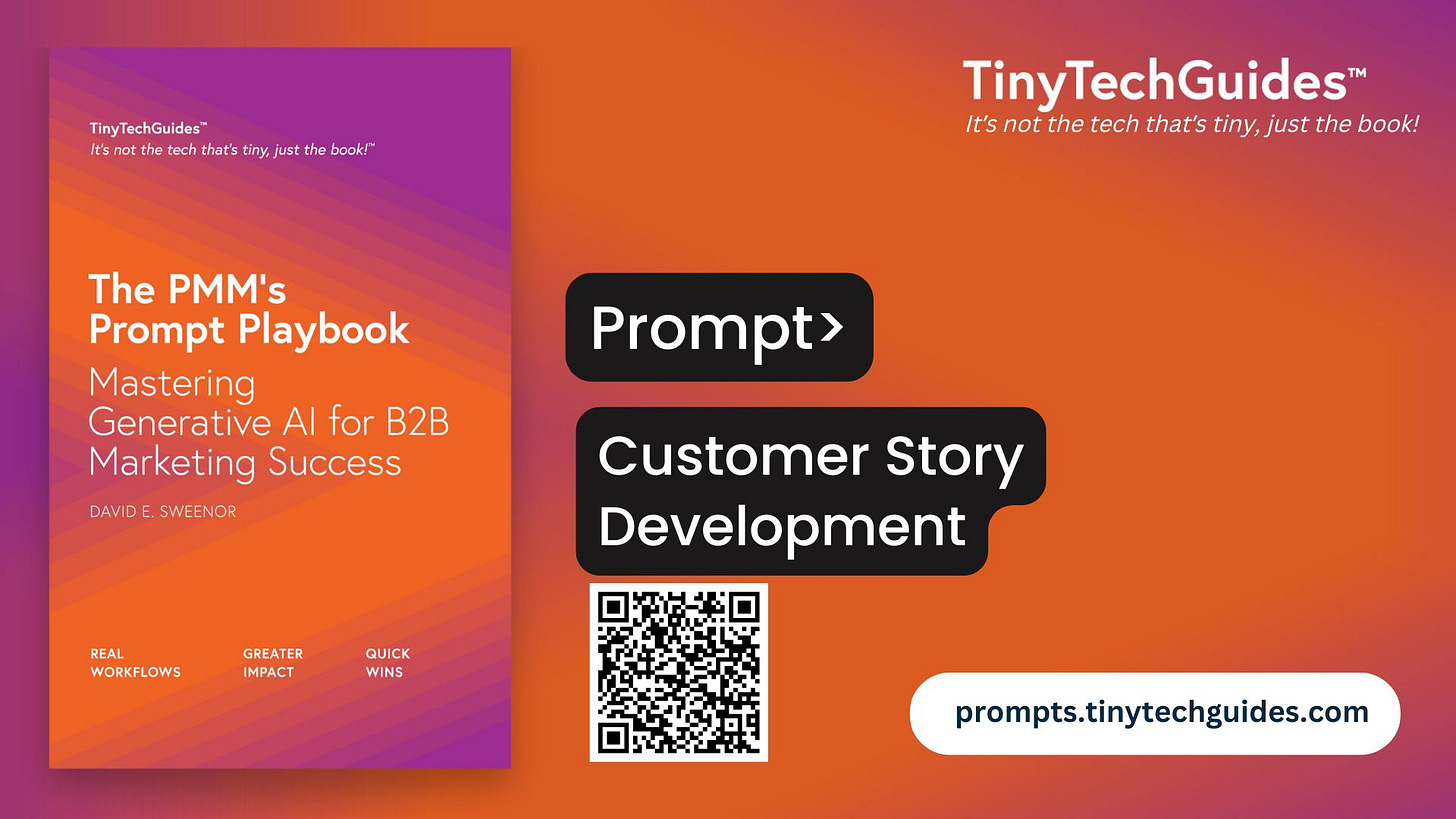Turn Case Studies Into Stories That Sell
This workflow shows you how to craft customer stories that resonate with buyers and drive deals forward
This prompt is not part of The PMM’s Prompt Playbook which has 30 ready-to-use prompts. If you’re looking for more cut-and-paste prompts, join the Substack! Paid subscribers receive new cut-and-paste prompts every week.
Get the PMM’s Prompt Playbook and Modern B2B Marketing today!
Need help with product marketing or prompts? Let me know.
Workflow Name: Customer Story Development
Created by prompts.tinytechguides.com
What This Workflow Does
This workflow turns an existing customer success story into a compelling narrative that highlights the real-world benefits of your product. By following a structured format — including the challenge, solution, and measurable results — it builds credibility and engages target buyers. Optional steps allow for strategic clarity, multi-voice storytelling, and easy content repurposing, making it ideal for marketers, sales teams, and content strategists.
Workflow Steps Summary
Step 0: Define Inputs
Step 1: Identify the Customer and Key Challenge
Step 1.5: Define Strategic Objective (optional)
Step 2: Describe the Solution Provided
Step 3: Highlight Measurable Results
Step 4: Incorporate Customer Quotes
Step 4.5: Pull Secondary Quotes or Perspectives (optional)
Step 5: Structure and Write the Story
Step 5.5: Create Repurposing Assets (optional)
Step 6: Internal Review and Approvals (optional)
Step 0: Define Inputs
{product} = Name of the product or service
{industry} = Customer’s industry
{customer_name} = Name or anonymized label for the customer
{persona} = Who this story is for (e.g., CFO, Ops Manager, IT Director)
{customer_challenge} = Key pain point the customer faced
{solution_description} = Overview of how the product addressed the issue
{quantifiable_results} = Metrics showing success (e.g., “30% cost reduction”)
{customer_quote} = Direct quote from customer (optional but powerful)
{secondary_quotes} = Additional quotes from other stakeholders (optional)
{repurposing_channels} = Where this story might be reused (e.g., sales deck, email, social)
{tone} = Tone of the piece (e.g., professional, conversational, confident)
{strategic_objective} = Goal of the story (e.g., lead gen, nurture, sales enablement)
If you have raw material, you can run this workflow first.
Step 1: Identify the Customer and Key Challenge
#Role
You’re a B2B case study writer focused on highlighting customer pain points in a compelling narrative.
#Context
The customer, {customer_name}, operates in the {industry} industry. They faced a specific challenge that is relevant to the target audience of {persona}.
#Task
Write a short paragraph summarizing who the customer is and the core challenge they were facing before using {product}. Make the problem relatable and high-stakes for the reader.
#Format
One paragraph, 3–5 sentences. Use a narrative style, no bullet points.
#Tone
{tone}
Step 1.5: Define Strategic Objective (Optional)
#Role
You are a content strategist aligning case study messaging with business goals.
#Context
This story needs to serve the objective of {strategic_objective}. Understanding this will guide tone, structure, and content emphasis.
#Task
Briefly outline how the customer story will support the strategic objective. Suggest how this should influence writing style, content focus, or distribution.
#Format
2–3 sentences, strategy-focused.
#Tone
Strategic and clear.
Step 2: Describe the Solution Provided
#Role
You’re writing the “Solution” section of a B2B customer story.
#Context
The customer used {product} to address the challenge described in Step 1. You need to highlight how {product} delivered value.
#Task
Summarize how the solution was implemented, which features were most helpful, and how it aligned with the customer’s goals.
#Format
1–2 paragraphs, broken into readable sentences. Use subheadings if helpful (e.g., “Implementation,” “Key Features”).
#Tone
{tone}
Step 3: Highlight Measurable Results
#Role
You are presenting the business impact of the product.
#Context
The solution produced measurable results for {customer_name}. These outcomes demonstrate the value of {product} to decision-makers in the {industry} space.
#Task
List the top 3–5 quantifiable outcomes from the implementation, using {quantifiable_results}.
#Format
Bullet list, each item should have a %/metric + a short description (e.g., “30% cost reduction within 6 months”).
#Tone
Data-driven, clear, and confident.
Step 4: Incorporate Customer Quotes
#Role
You’re a storyteller adding authenticity through the customer’s voice.
#Context
You’ve received a quote from the customer: {customer_quote}. Use it to reinforce a key point in the story.
#Task
Place the quote in the correct section (Challenge, Solution, or Results). Frame it to amplify the story’s impact.
#Format
Quoted text in quotation marks, followed by a short lead-in or follow-up sentence.
#Tone
Natural and credible.
Step 4.5: Pull Secondary Quotes or Perspectives (Optional)
Keep reading with a 7-day free trial
Subscribe to B2B Marketing Prompts by TinyTechGuides to keep reading this post and get 7 days of free access to the full post archives.



